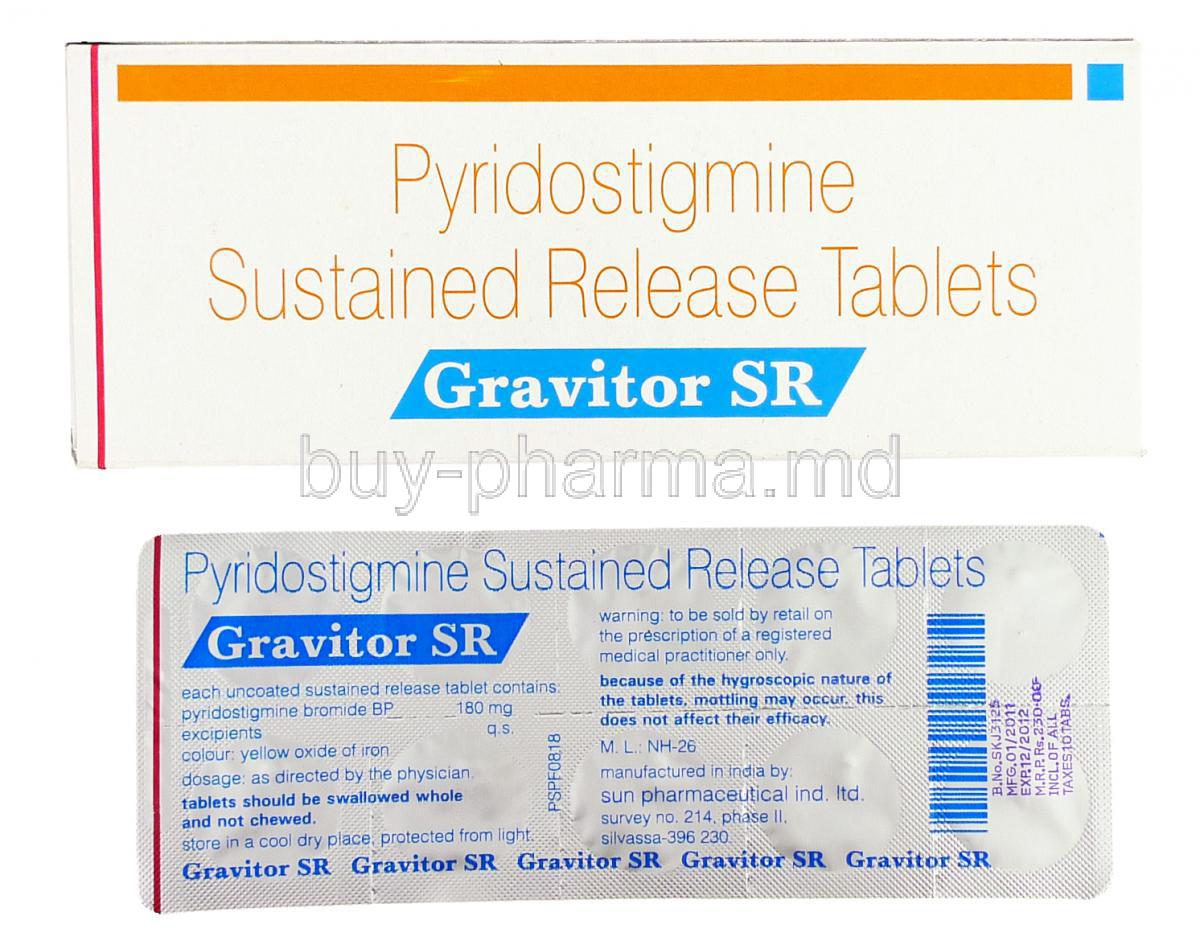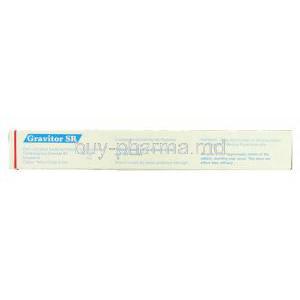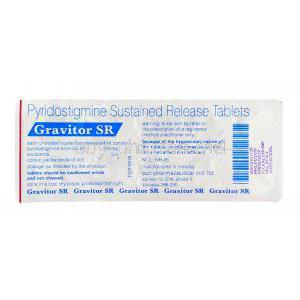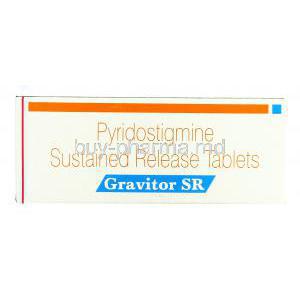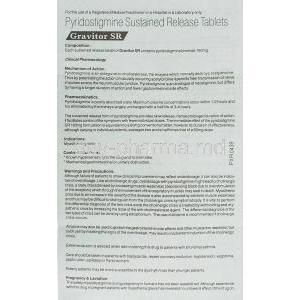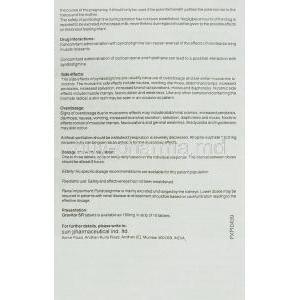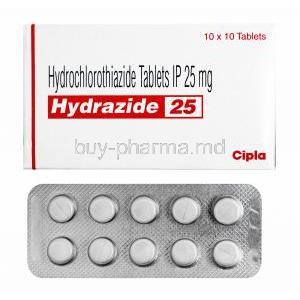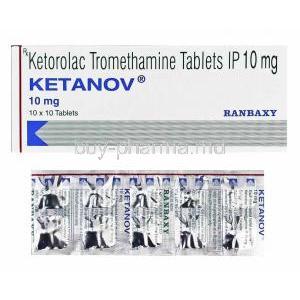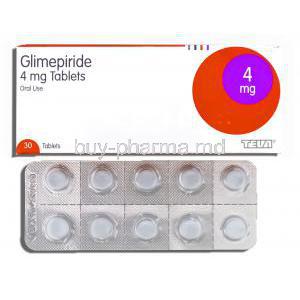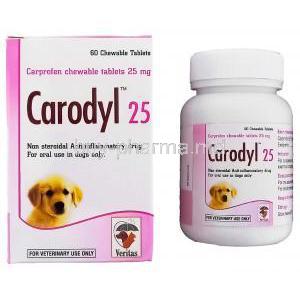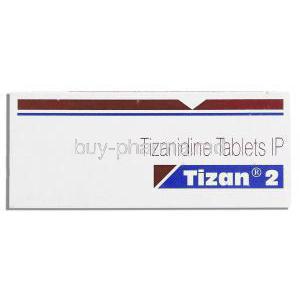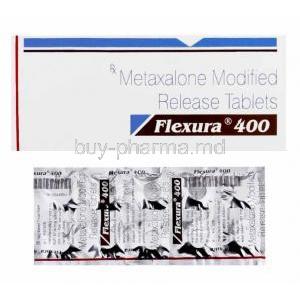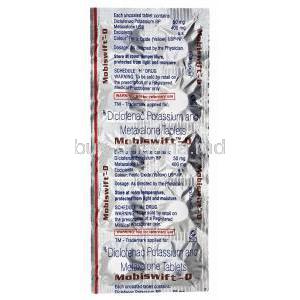1. Introduction to Gravitor
Gravitor (Pyridostigmine Bromide) is a clinically significant medication widely prescribed for neuromuscular disorders. Its therapeutic importance lies in its ability to enhance nerve-to-muscle communication, thereby improving muscle strength and endurance in patients suffering from debilitating conditions such as myasthenia gravis. Through decades of use, Gravitor has become a cornerstone of cholinesterase inhibitor therapy in both acute and chronic neurological management.
Discovered in the mid-20th century, pyridostigmine bromide was developed as a safer and longer-acting alternative to neostigmine. Over time, it has proven effective in both military and medical contexts—initially used for nerve agent protection and later as a mainstay therapy in neuromuscular medicine.
Classified pharmacologically as an acetylcholinesterase inhibitor, Gravitor works by preventing the breakdown of acetylcholine, a neurotransmitter essential for muscle contraction. By sustaining acetylcholine levels, it ensures smooth neuromuscular transmission and plays a vital role in regulating autonomic functions.
2. Composition and Pharmaceutical Form
The active ingredient in Gravitor is pyridostigmine bromide, a quaternary ammonium compound designed for controlled absorption and reduced central nervous system penetration. This property minimizes central side effects while maximizing peripheral therapeutic benefits.
Gravitor is available in various pharmaceutical forms to accommodate patient-specific needs:
- Oral tablets (standard and extended-release)
- Oral syrup for pediatric or swallowing-impaired patients
- Injectable solutions for rapid symptom control
Each formulation may include excipients such as lactose, maize starch, talc, and magnesium stearate. Brand equivalents include Mestinon and Regonol, available in multiple regions under both branded and generic labels.
3. Mechanism of Action
Gravitor exerts its pharmacological action by reversibly inhibiting the acetylcholinesterase enzyme. This inhibition prevents the breakdown of acetylcholine at neuromuscular junctions, resulting in prolonged stimulation of skeletal muscle fibers. The increased neurotransmitter availability enhances voluntary muscle activity and restores functional muscle strength in myasthenic patients.
In contrast to neostigmine and physostigmine, pyridostigmine demonstrates a longer duration of action and milder muscarinic side effects, making it preferable for chronic therapy. Its selective action on peripheral cholinergic sites ensures targeted efficacy with reduced systemic burden.
4. Therapeutic Uses of Gravitor
4.1 FDA-Approved Uses
- Myasthenia Gravis: Primary indication for symptomatic relief and long-term maintenance. Gravitor improves neuromuscular transmission, enhancing muscle tone and reducing fatigue.
- Reversal of Non-Depolarizing Neuromuscular Blockade: Used postoperatively to restore muscle function following anesthesia.
- Management of Postoperative Ileus and Urinary Retention: Stimulates smooth muscle contraction and facilitates recovery of normal physiological function.
4.2 Off-Label Uses
- Postural Orthostatic Tachycardia Syndrome (POTS): Enhances autonomic balance by supporting cholinergic transmission.
- Lambert-Eaton Myasthenic Syndrome (LEMS): Serves as an adjunct to improve neuromuscular junction efficiency.
- Chronic Fatigue Syndrome: Assists in restoring autonomic stability and reducing fatigue symptoms.
- Hypotension in Autonomic Failure: Improves vascular tone through enhanced parasympathetic control.
- Critical Illness Myopathy: Supports neuromuscular recovery during prolonged immobilization or intensive care management.
5. Dosage and Administration
5.1 Dosage Guidelines
The dosage of Gravitor is highly individualized, dependent on disease severity, patient weight, and response. For myasthenia gravis, the standard oral adult dose ranges between 60 mg to 120 mg every 3 to 4 hours. Parenteral administration may be required in acute exacerbations or preoperative settings.
- Pediatric patients: Adjusted per body weight and symptom response.
- Conversion: 1 mg parenteral ≈ 30 mg oral pyridostigmine bromide.
5.2 Administration Method
Oral doses should be taken with water and preferably after meals to minimize gastrointestinal discomfort. Extended-release tablets are designed for once or twice-daily dosing to maintain sustained plasma levels. Injectable routes include intramuscular and intravenous administration, primarily under hospital supervision. Regular dosing intervals are essential to prevent symptom fluctuations.
6. Side Effects of Pyridostigmine Bromide
6.1 Common Side Effects
- Gastrointestinal disturbances: nausea, diarrhea, abdominal cramping
- Increased salivation and perspiration
- Muscle twitching or mild transient weakness
- Frequent urination or urinary urgency
6.2 Serious or Rare Adverse Reactions
- Bradycardia or hypotension
- Bronchospasm, particularly in asthmatic individuals
- Seizures or confusion due to overdose
- Hypersensitivity rash or urticaria
7. Drug Interactions
Gravitor may interact with several pharmacologic agents, altering its efficacy or safety profile:
- Anticholinergic drugs (e.g., atropine, glycopyrrolate) may antagonize its effects.
- Corticosteroids can potentiate therapeutic benefits in myasthenic treatment.
- Neuromuscular blockers may exhibit antagonistic or synergistic effects.
- Beta-blockers and calcium channel blockers increase risk of bradycardia.
- Alcohol and high-fat meals may delay drug absorption.
8. Warnings and Important Precautions
Excessive dosing of Gravitor can precipitate a cholinergic crisis—a life-threatening condition marked by muscle weakness, respiratory depression, and hypersalivation. It is essential to differentiate between myasthenic crisis (underdosing) and cholinergic crisis (overdosing) through clinical observation and medical testing.
- Close supervision during dosage titration is crucial.
- Patients with asthma, bradycardia, or cardiac arrhythmias require careful monitoring.
- Use cautiously in those with gastrointestinal or urinary tract obstructions.
Regular monitoring of pulmonary function, gastrointestinal motility, and cardiovascular parameters is recommended throughout long-term therapy.
9. Contraindications
- Known hypersensitivity to pyridostigmine or bromide compounds
- Mechanical obstruction of the intestine or urinary tract
- Peritonitis or severe motility impairment
- Caution advised in patients with epilepsy, arrhythmias, or severe cardiac dysfunction
Gravitor remains one of the most valuable therapeutic tools in managing neuromuscular disorders, provided that administration is medically supervised and dosage is appropriately calibrated.
10. Careful Administration
The administration of Gravitor (Pyridostigmine Bromide) requires meticulous clinical supervision and individualized dosing. Each patient’s physiological response to the drug varies based on the degree of neuromuscular impairment, comorbidities, and concurrent therapies. A tailored dosing regimen helps to optimize efficacy while minimizing adverse cholinergic reactions.
Because pyridostigmine is primarily excreted through the kidneys, patients with renal impairment require dosage adjustments to prevent drug accumulation and toxicity. Regular renal function assessments are recommended for those on long-term therapy.
- Close monitoring in individuals with bronchial asthma is essential due to the risk of bronchospasm.
- Patients with bradycardia or conduction abnormalities should be supervised for cardiac rhythm changes.
- Those with a history of peptic ulcer disease must be observed for increased gastric acid secretion caused by cholinergic stimulation.
Periodic evaluations of muscle strength, fatigue levels, and signs of cholinergic excess (e.g., increased salivation, diarrhea, or cramping) are vital for maintaining therapeutic balance and avoiding crisis situations.
11. Special Population Considerations
11.1 Administration to Elderly Patients
Elderly patients often exhibit decreased renal clearance and a prolonged drug half-life, necessitating cautious dose initiation and slower titration schedules. Age-related physiological changes can amplify muscarinic side effects, including bradycardia and gastrointestinal hyperactivity. Therefore, initial therapy should begin with the lowest effective dose under close medical supervision.
Regular assessment of renal function, hydration status, and autonomic stability ensures safety and optimal therapeutic outcomes in this demographic group.
11.2 Administration to Pregnant Women and Nursing Mothers
Animal studies on pyridostigmine bromide have not revealed significant teratogenic effects, but human data remain limited. Classified under pregnancy risk category C, Gravitor should be used during pregnancy only when the potential benefits justify potential risks to the fetus. The medication may cross the placental barrier, warranting obstetric supervision during maternal therapy.
Since pyridostigmine is excreted into breast milk, breastfeeding mothers should be monitored for signs of neonatal exposure, such as hypotonia or muscle weakness in the infant. If necessary, temporary cessation of nursing or dose adjustment should be considered based on clinical evaluation.
11.3 Administration to Children
Gravitor is indicated in pediatric cases of juvenile myasthenia gravis, where its use enhances neuromuscular communication and muscle tone. Dosage in children is determined by body weight and response to therapy, typically requiring smaller and more frequent doses compared to adults.
- Careful titration prevents gastrointestinal intolerance and excessive salivation.
- Parents or caregivers should be trained to identify early signs of overdosage or adverse cholinergic effects.
Regular follow-ups ensure safe and effective long-term use in this population.
12. Overdosage and Toxicity
Excessive ingestion or administration of pyridostigmine can precipitate a cholinergic crisis, characterized by overwhelming muscarinic stimulation. Key symptoms include:
- Severe muscle weakness or paralysis
- Respiratory distress and depressed ventilation
- Bradycardia and hypotension
- Profuse salivation and sweating
- Miosis and gastrointestinal hyperactivity
Clinicians must distinguish between a myasthenic crisis (caused by underdosing) and a cholinergic crisis (caused by overdosing), as both manifest with muscular weakness but demand opposite interventions.
Emergency management involves prompt administration of atropine sulfate to counteract muscarinic effects, airway support, and continuous cardiovascular monitoring. In severe cases, hospitalization and ventilatory assistance are mandatory until recovery of neuromuscular function is achieved.
13. Handling and Storage Precautions
Gravitor should be stored under controlled room temperature, ideally between 15°C and 25°C, protected from moisture and direct light. Exposure to excessive humidity or heat may compromise tablet integrity and potency.
- Keep medication tightly sealed in its original container.
- Avoid refrigeration unless specifically instructed for injectable forms.
- Dispose of expired or unused medication responsibly—preferably through a local pharmacy or pharmaceutical waste program.
- Ensure secure storage out of reach of children to prevent accidental ingestion or misuse.
Proper handling and adherence to storage guidelines preserve the drug’s stability and therapeutic value throughout its shelf life.
14. Summary and Clinical Outlook
Gravitor remains a cornerstone in the management of neuromuscular disorders, notably myasthenia gravis, due to its ability to sustain acetylcholine activity and restore effective nerve-muscle communication. When administered with precision, it provides consistent improvement in muscle endurance and overall functionality.
Long-term therapy with pyridostigmine bromide enhances patients’ quality of life by reducing fatigue and maintaining stable muscle performance. Patient education is crucial—understanding dosing schedules, recognizing crisis symptoms, and adhering to medical guidance are key to successful management.
Emerging research continues to explore its potential in treating autonomic dysfunctions and conditions associated with neuromuscular weakness. As advancements in neuropharmacology evolve, Gravitor remains a reliable therapeutic agent that bridges symptomatic control with sustained neuromuscular health.

